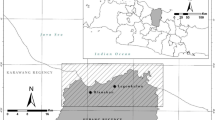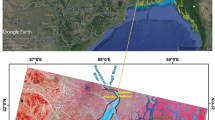Abstract
Creeks are the inherent coastline feature that connects rivers to the sea and plays an important role in the ecological processes and the material transfer. In the present study, an impact of urbanisation on the creeks of Mumbai, India namely Thane, Malad and Manori creeks, has been addressed. Multi-temporal satellite images of Landsat for the years 1972, 1994 and 2016 are considered to perform the changes in the mudflat and growth of the mangrove, as well as the changes in creeks width apart from the Land use Land cover (LULC). Object-based image analysis using multi-spectral resolution confirmed that there is an overall increase in the spatial extent of mangroves and reduction in the width of all the creeks. Mangroves around Thane creek and Manori creek have increased from 50.7 km2 to 57.6 km2 and 8.4 km2 to 25.2 km2respectively. However, there is a decrease in mangroves around Malad Creek from13.3 km2 to 9.7 km2during 1972 to 2016. The relationship between the creek geometry and LULC was also explored, and it has been revealed that the creek width has reduced due to urbanisation. Life expectancy analysis projected a further reduction in the width of the creeks for the years 2025 and 2050. The study suggests that there must be stringent bye-laws for disposal of sewage into the creeks and development activity near the creek areas. Further, upper stretches of the creeks require cleaning and dredging so that the tidal water will be approached up to the upper portion to maintain the creek ecosystem.















Similar content being viewed by others
References
Athalye RP, Quadros G, Gokhale KS (2012) Environmental management strategies for creeks and estuaries: a case study of Thane Creek India. Bionano Front
Blaschke T (2010) Object based image analysis for remote sensing, ISPRS Journal of Photogrammetry and Remote Sensing 65(1):2–16
Carlson TN, Sanchez-Azofeifa GA (1999) Satellite remote sensing of land-use changes in and around San Jose, Costa Rica. Remote Sens Environ 70(3):247–256
Chaves AB, Lakshumanan C (2008) Remote sensing and GIS-based integrated study and analysis for MangroveWetland Restoration in Ennore Creek, Chennai, South India. In: Proceeding of Taal2007: The 12th World Lake Conference, p 685
Chen LC (1998) Detection of shoreline changes for tideland areas using multi-temporal satellite images. Int J Remote Sens 19(17):3383–3397
Dezso Z, Bartholy J, Pongracz R, Barcza Z (2005) Analysis of land-use/land-cover change in the Carpathian region based on remote sensing techniques. Physics and Chemistry of the Earth, Parts A/B/C, 30(1–3), 109–115
Enderle DI, Weih RC Jr (2005) Integrating supervised and unsupervised classification methods to develop a more accurate land cover classification. J Ark Acad Sci 59(1):65–73
Gangadhara Bhat H, Subrahmanya KR (1993) Paleoshorelines and coastal processes in Dakshina Kannada, Karnataka, India: a study based on remotely-sensed data. Int J Remote Sens 14(17):3311–3316
Guerschman JP, Paruelo JM, Bella CD, Giallorenzi MC, Pacin F (2003) Land cover classification in the Argentine Pampas using multi-temporal Landsat TM data. Int J Remote Sens 24(17):3381–3402
Hay GJ, Castilla G (2006) Object-Based Image Analysis: Strengths, Weaknesses, Opportunities and Threats (SWOT). International Archives of Photogrammetry, Remote Sensing and Spatial Information Sciences, XXXVI-4/C42
Jensen JR (2009) Remote sensing of the environment: an earth resource perspective 2/e. Pearson Education India
Jones HG, Vaughan RA (2010) Remote sensing of vegetation: principles, techniques, and applications. Oxford university press, Oxford/New York
Kamble SR, Vijay R (2011) Assessment of water quality using cluster analysis in the coastal region of Mumbai, India. Environ Monit Assess 178(1):321–332
Kulkarni VA, Jagtap TG, Mhalsekar NM, Naik AN (2010) Biological and environmental characteristics of mangrove habitats from Manori creek, West Coast, India. Environ Monit Assess 168(1):587–596
Liu Y, Li M, Mao L, Xu F, Huang S (2006) Review of remotely sensed imagery classification patterns based on object-oriented image analysis. Chin Geogr Sci 16(3):282–288
Lucas R, Mitchell A, Bunting P (2008) Hyperspectral data for assessing carbon dynamics and biodiversity of forests. Taylor & Francis Group, New York, pp 47–86
Mendiratta P, Gedam S (2014) The Dynamic Land form - Thane creek and its profile, ISPRS Proceeding Papers of Sort Interactive Session ISPRS TC VIII International Symposium on “Operational Remote Sensing Applications: Opportunities, Progess and Challenges” 9(12), Hyderabad, India
Mukherji D (2002) Degradation of creeks and mangroves and its impact on urban environment- a case study of Mumbai. In: Proceedings of the national seminar on Creeks, Estuaries and Mangroves- Pollution and Conservation, 28 th to 30 th November, 2002, Thane, pp 331–333
Nayak S, Bahuguna A, Shaikh MG, Rao RS (1991) Manual for mapping of coastal wetlands, landforms and shoreline changes using satellite data. Technical note. 63-64
Odum EP, Barrett GW (1971) Fundamentals of ecology, vol 3. Saunders, Philadelphia
Pomeroy LR, Kuenzler EJ (1969) PHOSPHORUS TURNOVER BY CORAL REEF ANIMALS (No.CONF-670503–). Georgia Univ., Athens. Dept. of Zoology; North Carolina Univ., Chapel Hill. Dept. of Environmental Sciences and Engineering
Rajawat AS, Chauhan HB, Ratheesh R, Rode S, Bhanderi RJ, Mahapatra M, Kumar M, Yadav R, Abraham SP, Singh SS, Keshri KN, Ajai (2015) Assessment of coastal erosion along the Indian coast on 1 : 25,000 scale using satellite data of 1989–1991 and 2004–2006 time frames. Curr Sci 109(2):347–353
Rao BRM, Venkataratnam L (1991) Monitoring of salt affected soils—a case study using aerial photographs, salyut-7 space photographs, and Landsat TM data. Geocarto Int 6(1):5–11
Rogan J, Chen D (2004) Remote sensing technology for mapping and monitoring land-cover and land-use change. Prog Plan 61(4):301–325
Rundquist BC, Harrington JA Jr, Goodin DG (2000) Mesoscale satellite bioclimatology. Prof Geogr 52(2):331–344
Sasamal SK, Rao KH, Suryavansi UM (2007) Sewage and industrial pollution in and around Thane Creek, Mumbai using high resolution IRS data. Int J Remote Sens 28(19):4391–4395
Sreekala SP, Baba M, Muralikrishna M (1998) Shoreline changes of Kerala coast using IRS data and aerial photographs. Indian J Mar Sci 27(1):144–148
Sujatha G, Dwivedi RS, Sreenivas K, Venkataratnam L (2000) Mapping and monitoring of degraded lands in part of Jaunpur district of Uttar Pradesh using temporal spaceborne multispectral data. Int J Remote Sens 21(3):519–531
Tirkey N, Biradar RS, Pikle M, Charatkar S (2005) A study on shoreline changes of Mumbai coast using remote sensing and GIS. J Indian Soc Remote Sens 33(1):85–91
Verma KS, Saxena RK, Barthwal AK, Deshmukh SN (1994) Remote sensing technique for mapping salt affected soils. Int J Remote Sens 15(9):1901–1914
Vijay R, Khobragade PJ, Sohony RA, Kumar R, Wate SR (2014) Hydrodynamic and water quality simulation of Thane creek, Mumbai: an impact of sewage discharges. Indian J Geo-Mar Sci 43(10):1891–1898
Vyas L, Vyas S (2007) Simulation models for the dispersion of sewage outfalls along the west coast of Mumbai, India. In: Proceedings of the 7th WSEAS international conference on Simulation, Modeling and Optimization, Beijing, China, pp 503–508
Zha Y, Gao J, Ni S (2003) Use of normalized difference built-up index in automatically mapping urban areas from TM imagery. Int J Remote Sens 24(3):583–594
Author information
Authors and Affiliations
Corresponding author
Additional information
Publisher’s note
Springer Nature remains neutral with regard to jurisdictional claims in published maps and institutional affiliations.
Rights and permissions
About this article
Cite this article
Vijay, R., Dey, J., Sakhre, S. et al. Impact of urbanization on creeks of Mumbai, India: a geospatial assessment approach. J Coast Conserv 24, 4 (2020). https://doi.org/10.1007/s11852-019-00721-y
Received:
Revised:
Accepted:
Published:
DOI: https://doi.org/10.1007/s11852-019-00721-y




